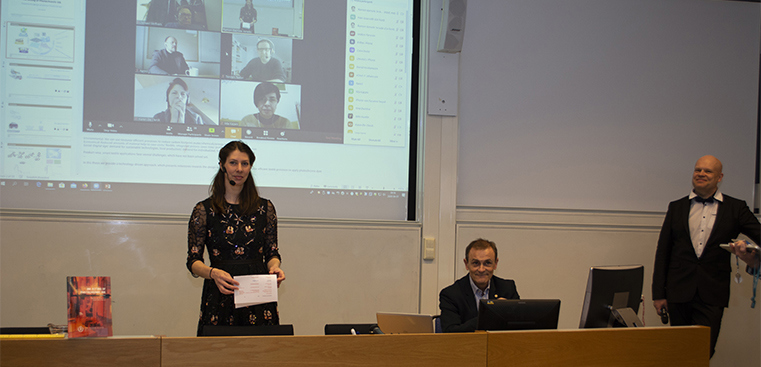The university's first public thesis defence via video link
2020-04-08

"It was never an option for us to cancel. We are very pleased with the results," says Eva Gustafsson, Director of Studies for the doctoral programme Textiles and Fashion and Chair of the Research and Education Board.
After several years of doctoral education, it was finally time for the doctoral student to publicly defend her thesis and, hopefully, be awarded her doctorate. How a public thesis defence is to be conducted is carefully regulated, with demands that the examining committee and the external examiner be present and that the public be able to participate. In March, the coronavirus crisis forced new guidelines approving the use of video link.
Cancelling public defences or licentiate seminars due to restrictions on physical meetings and travel was never an option, according to Eva Gustafsson.
“No, it wasn't. The Swedish Higher Education Authority quickly signalled that higher education institutions could conduct these differently. We developed guidelines for the university, including that the examining committee should be able to take part in the entire public defence and have the opportunity to discuss and give ratings in an individual virtual room.”
Reserves in place
Yesterday, Sina Seipel defended her thesis Ink jetting of photochromic ink – Towards the design of a smart textile sensor. External examiner Karen De Clerck, a professor at Ghent University in Belgium, as well as members of the examining committee and other audience members, such as Sina Seipel's family in Germany and Canada and colleagues from the university, participated via video link.
In addition to Sina Seipel, there were, among others, Eva Gustafsson and Associate Professor Nils-Krister Persson, who was a reserve in case technical problems caused someone on the examining committee to be unable to participate. About ten colleagues were in the physical hall, seated few and far between.
When Sina Seipel presented her thesis, she shared her screen with the approximately 40 people who followed the public defence via video link. Professor Mikael Skrivfars, also via video link, acted as moderator.
After the examining committee and external examiner asked their questions, they temporarily moved to a separate virtual room to deliberate. They later returned to the open virtual room and announced that Sina Seipel's thesis had been approved and praised her for her work and her good presentation.
"It is a bit unusual to conduct a public defence in this way, but I am convinced that the quality of the public defence was not affected by the virtual format. The technology and communication between the different parties worked excellently,” Sina Seipel summarised afterwards.
Opens up for more participants
Eva Gustafsson says that there were two risks to take into account in the planning of the virtual public defence. Technical problems is one thing, and an overly rigid feeling to the event is another.
"Given the technology, it is important to have a Plan B. We had designated reserves in case someone couldn't participate, and phones were at the ready in case someone's network were to go down. It worked very well this time; we were well prepared with a plan and received good support," says Eva Gustafsson.
Perhaps the new experience will mean that there will be more virtual disputations, even after the coronavirus crisis.
"It’s something we can consider now that we have tested this and the infrastructure has been expanded. This would save many trips and expenses associated with public defences. If some people can participate remotely, it opens up opportunities because we can invite more people to be part of the examining committee.”
Read more
About the university's guidelines: How the novel coronavirus pandemic will affect doctoral thesis defences and licentiate seminars
About Sina Seipel's thesis: New production method can bring smart textiles to market
Text: Lina Färm
Photo: Solveig Klug
Translation: Eva Medin

